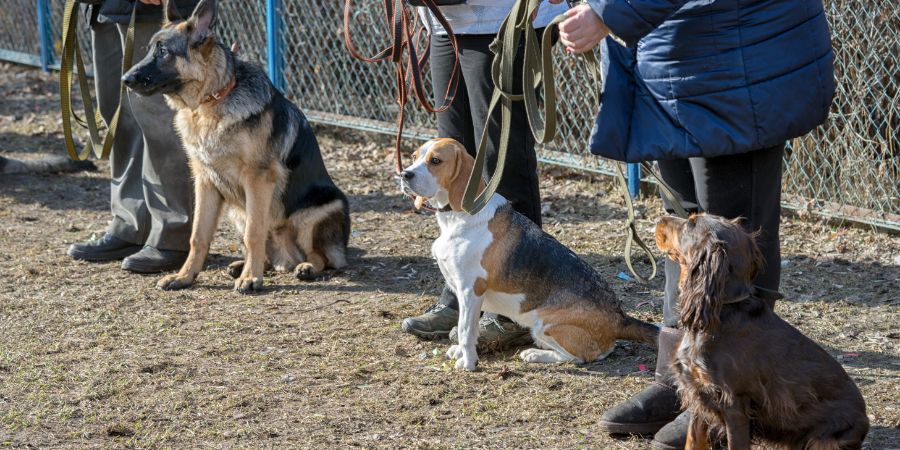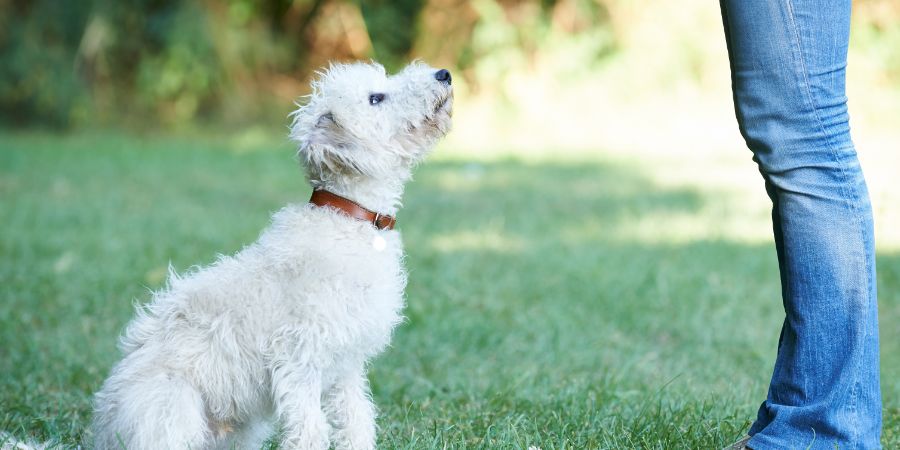Are you an aspiring or experienced dog trainer looking for help creating a lesson plan? Creating individualized and group training sessions can be challenging… But with the right tools and strategies, you can design engaging classes that inspire both dogs and owners. In this guide, we’ll discuss how to design a dog training lesson plan for all level of dog owners – as well as individual vs. group classes!
So, keep reading to learn how to design an effective and engaging dog training lesson plan!
How to Design a Dog Training Lesson Plan: Getting Started
A successful lesson plan starts with having clearly defined goals in mind. So, start by asking yourself:
- Do you intend to offer one-on-one sessions, group classes, or both?
- What are the objectives you want to accomplish throughout the class?
- How will participants interact?
- In what ways will knowledge be assessed?
- How much time do you have available per session?
Having answers to these questions before getting started makes it easier to create a lesson plan that’s tailored to the needs of your students. Once you have a vision in mind, you can use it to create goals and design activities!

Ask Yourself the 5 W’s (and H)
The 5 W’s (and How) is a helpful strategy to use when designing your dog training lesson plan. It can help you identify what information needs to be taught, as well as how it will be communicated and assessed.
Therefore, start by asking yourself:
- WHO: Who’s taking the class? Is it for owners of all breeds and ages, or are there any restrictions?
- WHAT: What goals will the class cover by the end of the session? How can you make sure these objectives are met?
- WHEN: How much time is available for each topic in your lesson plan? How often should classes be held throughout the year?
- WHERE: Where will the class be held? How will the environment affect your lesson plan design?
- WHY: Why are these topics important to teach in a dog training session? How can you best make sure that your students understand why they’re learning the material?
- HOW: How will information be communicated, assessed, and reinforced over time? In what ways will you measure success?
When you consider these questions carefully, you’ll be able to come up with a lesson plan that’s properly tailored to the needs of your students. Not to mention, it will make it easier to determine if any changes need to be made throughout the course!
Decide How to Structure Your Dog Training Class
A lesson plan should provide a framework for the class structure. This can include multiple sections that allow you to introduce topics, teach techniques, give students practice time, and assess knowledge.
Importantly, these sections should be clearly-defined and easy-to-follow. That way, you can make sure participants understand what’s expected of them throughout each session!
Design Activities for Your Dog Training Lesson Plan
After creating the framework for your class, it’s time for you to design activities that will help foster learning and understanding. When designing activities, you should keep in mind the goals and objectives you established in the previous section!
Moreover, consider how activities can be tailored to meet specific needs or skill levels. You should also think about how they might be adapted for one-on-one sessions versus group classes. Additionally, plan for enough practice time to ensure that your clients are able to apply the skills learned during class once they’re back at home with their pup(s).
Pro Tip: Not yet a certified dog trainer? Our Step-by-Step Guide will walk you through the process from start to finish… Even if you have no prior experience!
Assessing Training Progress
Obviously, assessing the dogs’ progress is going to be a VERY important part of any dog training lesson plan. Without it, you won’t be able to accurately tell how well a dog is doing – or how much they’ve improved. Furthermore, you won’t know how to identify any necessary changes in your curriculum.
So, make sure to include an assessment component at the end of each session. This can be done through testing, observation, or any other methods that help you evaluate a dog’s performance.

Assessing Participant Knowledge
Fact: it’s not just the dogs who are learning from your classes… But also their owners, too! For this reason, it’s just as important to make sure that your human clients are absorbing and understanding the things you’re teaching.
When it comes to assessing this kind of participant knowledge, there are a few different approaches you can take. One way is to provide participants with written exams or quizzes, which can be graded and returned to the students after class. Also, you could have the dog owners complete oral assessments during practice time in order to gauge how much they’ve learned.
And finally, depending on the class size, you could also have clients answer questions in a group format. Doing so would give you the opportunity to provide feedback and correct any misconceptions right away!
Clearly Set Your Expectations in Your Lesson Plan
In terms of expectations, there are 3 main categories you should provide clients information about:
- Location;
- Attendance;
- And Required Materials.
Location
Where will participants meet and what time does the class start? How early should they arrive? Are there any safety considerations to note?
Attendance
How large are the classes you’ll teach? What’s your policy for late arrivals or missed lessons? Do clients need to sign up for one-on-one sessions in advance?
Required Materials
Will participants need to bring any materials such as toys, treats, or a clicker? How will they receive course materials and/or handouts? Furthermore, are there any additional items they need to purchase in order to participate in your classes?
How to Create a Basic Lesson Plan for Dog Training: Individual vs. Group Classes
Next, let’s look a little closer at the difference between designing a lesson plan for individual versus group classes. Although they share many similarities, there are some key differences to be aware of!
Individual Classes
In individual classes, you’ll have more control over the environment and be able to discuss topics at a deeper level. As the instructor, you’ll also have more flexibility in adapting the curriculum to meet each dog’s specific needs. Another perk? You’re able to adjust the lesson plan as needed – and with a lot more ease, since you only have one client and their dog to worry about!
Group Classes
With group classes, you’ll have to accommodate a wider range of skill levels while also keeping the class running smoothly. Moreover, you’ll need to pre-plan activities and exercises that can be adjusted on the fly to meet each student’s needs. In addition, make sure to allow for plenty of practice time so that all class participants can learn by doing.
Pro Tip: Discover how to get clients as a dog trainer!
Tailoring Your Lesson Plan to Different Levels of Dog Owners
Now, depending on your class size, you may have participants that range from beginner dog owners to more experienced ones. For this reason, it’s important to adjust your lesson plan accordingly.
For example, if you’re teaching a group class, you can create two or three “tracks” for different levels of experience. This will allow you to provide a more customized approach and avoid overwhelming students who are new to dog training.
On the other hand, if you’re teaching an individual class, you can tailor your lesson plan to each client’s specific needs. Plus, you can adjust each lesson on the fly as needed. Doing so will allow you to provide your clients with the most relevant and useful information possible!

Providing Clients with Homework
Finally, no lesson plan is complete without homework!
Giving dog owners tasks to do with their pup between classes will help reinforce the skills taught in class. In turn, this can help ensure that they’re able to keep up with the learning process and make greater progress.
Here are some examples of the kind of homework you can assign your clients:
- Practice the commands and tricks taught in class;
- Take their pup for daily walks to reinforce good behavior;
- Give their pup mental stimulation with puzzle toys;
- Organize playdates with other dogs in the area to continue improving socialization;
- Read books, watch videos and attend seminars to stay up-to-date with the latest dog training techniques;
- Keep track of their pup’s progress with a journal or log, etc.
Mistakes to Avoid
Okay, so you want to design a dog training lesson plan, right? Of course, that’s why you’re here! But it isn’t enough to just know what to do – it’s also important to know what NOT to do.
So, here are a few mistakes that you’ll want to avoid when creating a lesson plan for your dog training classes:
- Failing to set clear expectations;
- Not providing enough practice time;
- Not properly assessing participant knowledge;
- Being too rigid and not being able to adjust the lesson plan as needed;
- Not providing clear instructions to class participants;
- Over-relying on lecture-based instruction;
- Forgetting to assess participant knowledge.
So long as you steer clear of these mistakes, you should have no problem creating an effective and comprehensive lesson plan!
Frequently Asked Questions
Alright, let’s wrap things up by answering some commonly asked questions about designing a dog training lesson plan (and dog training in general)!
Q: How do I keep a group class running smoothly?
A: Make sure to plan activities that can be adjusted on the fly to fit different skill levels, and provide plenty of practice time. This will help ensure that all participants are able to learn at their own pace and keep up with the lesson plan.
Q: How do I make a dog training plan at home?
A: If you’re a dog owner who’d prefer to try training their dog themselves, you can find plenty of resources online. As an example, our blog, Sniffin’ Around, has some great dog training advice!
However, it’s still important to make sure that you’re using the right techniques and following the proper safety protocols. It’s also never a bad idea to consult with a professional dog trainer for further guidance.
Q: How often should I teach my dog new commands?
A: That really depends on your pup! Some dogs learn quickly, while others may need more time to pick up the new commands. As a general rule of thumb, though, it’s best to spend a few minutes each day training your pup so that they don’t forget what they’ve learned.
Q: What is structure in dog training?
A: Structure in dog training is the practice of providing your pup with clear boundaries and expectations. This will help them understand what behaviors are acceptable, as well as which ones are not.
It’s also important to provide your pup with positive reinforcement when they obey commands or display good behavior. This will help encourage their learning process!
Pro Tip: Learn more about positive reinforcement – and why it’s considered the BEST method of dog training!

Q: What are the 4 stages of learning in dog training?
A: Generally speaking, there are four stages of learning in dog training. These include:
- Acquiring knowledge and understanding;
- Practicing new skills;
- Consolidating the skills learned;
- And mastering the learned behavior.
It’s important to remember that each stage requires time, patience, and repetition. So, don’t be discouraged if your pup isn’t picking it up immediately! With a little time and a lot of love, they’ll soon become a pro.
Q: What are the 7 commands to train a dog?
A: The seven most common commands to train your pup are as follows:
- Sit
- Stay
- Lie down
- Come
- Heel
- Off
- Leave it
Again, each of these commands should be accompanied by plenty of positive reinforcement in order for them to learn the behavior effectively.
Q: How do I write a simple training plan?
A: Writing a simple training plan for your pup doesn’t have to be difficult!
Start by outlining your goals, as well as the commands you want them to learn. From there, break up each command into small, manageable steps. Make sure to provide plenty of practice time, positive reinforcement, and clear expectations during each stage of learning.
Q: What are the 5 golden rules of dog training?
A: The five golden rules of dog training are:
- Be consistent!
- Be patient!
- Keep sessions short and sweet!
- Reward good behaviors!
- Be firm but fair in your expectations for your pup!
By following these key principles, you’ll be well on your way to having a happy and obedient pup in no time!
Helpful Resources to Bookmark
If You’re a Dog Owner
If You’re a Dog Trainer
- How to Choose a Dog Training School
- 10 Tips for Passing Your Dog Training Certification Course
- 7 Dog Trainer Career Options Once You’re Certified
- How to Start a Dog Training Business
- The 30 Best Tools to Grow Your Dog Training Business
- How Much Does it Cost to Start a Dog Training Business?
- How to Set Your Rates as a Dog Trainer
- Naming Your Dog Training Business: Everything You Need to Know
- How to Brand Your Dog Training Business
- How to Boost Revenue for Your Dog Training Business
- Salary Expectations for a Dog Trainer
- The 6 Fundamentals of Safe Dog Training
Conclusion
Hopefully this article has helped answer some of your burning questions about designing a dog training lesson plan. If you’re interested in learning more, be sure to check out our blog for more helpful tips and tricks.
Got any questions or comments? Maybe some tips on designing a dog training lesson plan that we didn’t cover in this article?
Drop them down below – we always love to hear from you!
Happy training, and thanks for reading!




